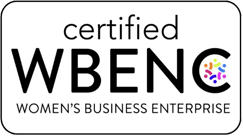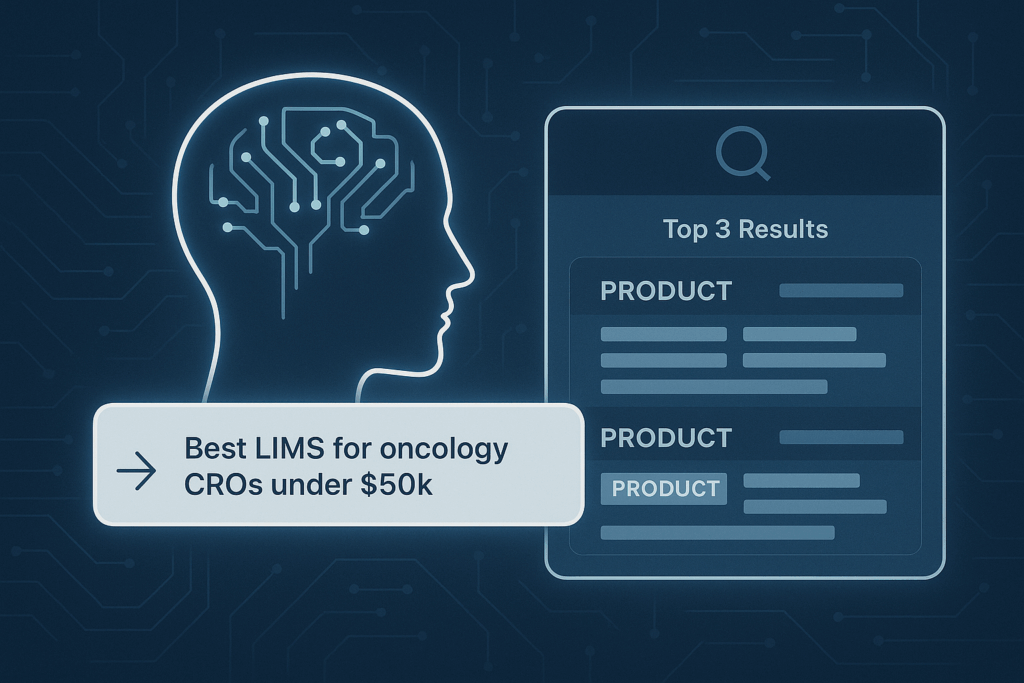In the high-stakes world of life sciences, purchasing decisions for tools, software, and technology are typically long, cautious, and complex. Decision-makers in biopharma, academia, and R&D are risk-averse, and for good reason: product validation, security, compliance, and long-term support are non-negotiable.
However, something unexpected is happening. AI isn’t just on the horizon; it’s already in the buyer’s inbox, search bar, and vendor shortlists. Tools like ChatGPT, Gemini, and Perplexity are quietly transforming how procurement leads, R&D directors, scientists, and digital innovation teams evaluate products and services. Buyers aren’t just Googling anymore. They’re prompting and asking questions like:
- “What’s the best preclinical data management platform with GxP compliance under $20k/year?”
- “Which LIMS vendors offer native integrations with cloud storage and audit trails?”
- “Rank the top 5 AI drug discovery platforms based on security certifications and scalability.”
- “Identify the top 5 providers for literature review software ranked by price and fit.”
These queries don’t go to your sales team. They go to an AI agent, and that agent responds instantly, using the data it can find. If your company isn’t in that response, you’re out of the running before the race even starts.
In Sciencia’s GenAI testing lab, we’re constantly learning how these chat tools are being used by scientists to research products, compare features, and make decisions. Every AI query is a sales opportunity, and the key is to build a digital strategy that makes your company AI-visible.
Why Life Sciences B2B Buying Is Being Reshaped
The life sciences sector is undergoing a shift from a seller-led process to a machine-mediated buyer journey. Where we once had cold calls, RFPs, and multi-month evaluation processes, we now have:
- Autonomous pre-research by AI agents.
- AI-generated comparison charts based on public content.
- Summarized feature sets pulled directly from your website structure.
- Shortlists created without any human sales interaction.
The takeaway? Your digital strategy, not your marketing and sales deck, is now the first asset enabling you to win business. To stay discoverable and competitive, your digital strategy must evolve beyond traditional SEO and lead forms. It must become AI-visible.
Here’s how you can make that happen:
1. Structure Product Content for Machine Understanding
AI tools don’t guess, they parse and infer. If your content isn’t structured in a way they can understand, you won’t be referenced and/or found.
- Use schema markup for features, pricing, security, and regulatory claims.
- Create use-case-specific pages that clearly define what your biotech product or lifes science software does and who it’s for.
- Avoid general marketing language in favor of machine-parsable data (e.g., tables, bullet lists, FAQs).
✅ Example: Instead of “flexible and customizable solutions,” say “includes 21 CFR Part 11 audit trails, FDA eCTD submission export, and oncology trial templates.”
2. Make Pricing and Fit Transparent
Even approximate pricing information helps AI categorize and recommend your product. If you don’t provide it, you’re left out of the comparison.
- Use ranges, tiers, or example quotes.
- Include buyer-aligned phrases like “best for teams under 10 users” or “suitable for academic-industry consortia, “best for academic licenses”
- Ensure pricing is embedded in crawlable HTML, not buried in gated PDFs.
3. Design Content for AI-Led Query Matching
The most successful vendors in this new era are anticipating how people ask AI for help and designing pages to match.
Build content around high-intent questions like:
- “Top life science SaaS for managing clinical data securely”
- “Compare preclinical research platforms by audit-readiness and pricing”
- “Best ELN/LIMS tools for GLP-compliant CROs in oncology space”
- “Best CDMO for cell and gene therapy, comparing pricing and services
Use clear H1/H2s, FAQ sections, comparison charts, and language that helps large language models (LLMs) confidently include your product in their responses.
4. Fast-loading, Indexable, Responsive Sites are Rewarded
Ditch heavy PDFs and replace them with structured, responsive HTML content. AI models, just like human researchers, value speed and accessibility.
- Publish current information on integrations, security audits, certifications, and use cases.
- Link to credible external sources (scientific publications, regulatory bodies, integration partners).
5. Feed the AI Ecosystem with Trustworthy Signals
AI agents use a mix of your own site and third-party context to validate and rank recommendations. Build your discoverability in that broader ecosystem.
- Use consistent naming conventions across review platforms, press releases, and directories.
- Publish explainer content that other websites and tools can cite.
- Offer APIs or structured feeds where appropriate so you can control your product’s “AI profile.”
- Create content that is well researched and validated, not some AI slop
Your Buyer May Not Be AI-Native, But Their Tools Are
Let’s be clear: your buyer still values human connection, due diligence, and domain expertise. But the tools they’re using to inform their first impressions, shortlist vendors, and build internal business cases? Those tools are automated, fast, and uninterested in anything they can’t clearly parse and cite.
The question every life science product or SaaS company must now ask is simple: If a buyer asks an AI which product is best, will your company be in the answer?
AI Visibility Checklist for Life Science Product or Life Science SaaS Companies
| Strategic Area | Traditional Approach | AI-Optimized Approach |
| Product Positioning | Broad claims, siloed features | Specific use cases, structured metadata |
| Pricing Visibility | “Contact us” or gated PDFs | Tiered pricing or clear ranges in HTML |
| Feature Descriptions | Vague benefit language | Machine-readable, comparison-ready formats |
| Website Structure | JavaScript-heavy, marketing-led | Fast, clean, schema-enhanced, mobile-optimized |
| Ecosystem Integration | Occasional partner mentions | Linked citations, guest posts, community mentions, social media activity |
Conclusion: Your Digital Strategy Compliments Your Sales Strategy
AI is no longer just helping buyers; it’s driving the buying process. If your content is vague, gated, or invisible to LLMs, your brand doesn’t just lose visibility. It becomes invisible by design.
To win in this new era, your content must be structured, cited, and AI-comprehensible. That’s not just marketing, that’s survival.
Ready to assess how your life science product or life science SaaS company shows up in AI search? Start with a simple prompt:
“What are the top life science product/software platforms for [your category]?”
If your name doesn’t appear in the answer, it’s time to rethink your strategy.




